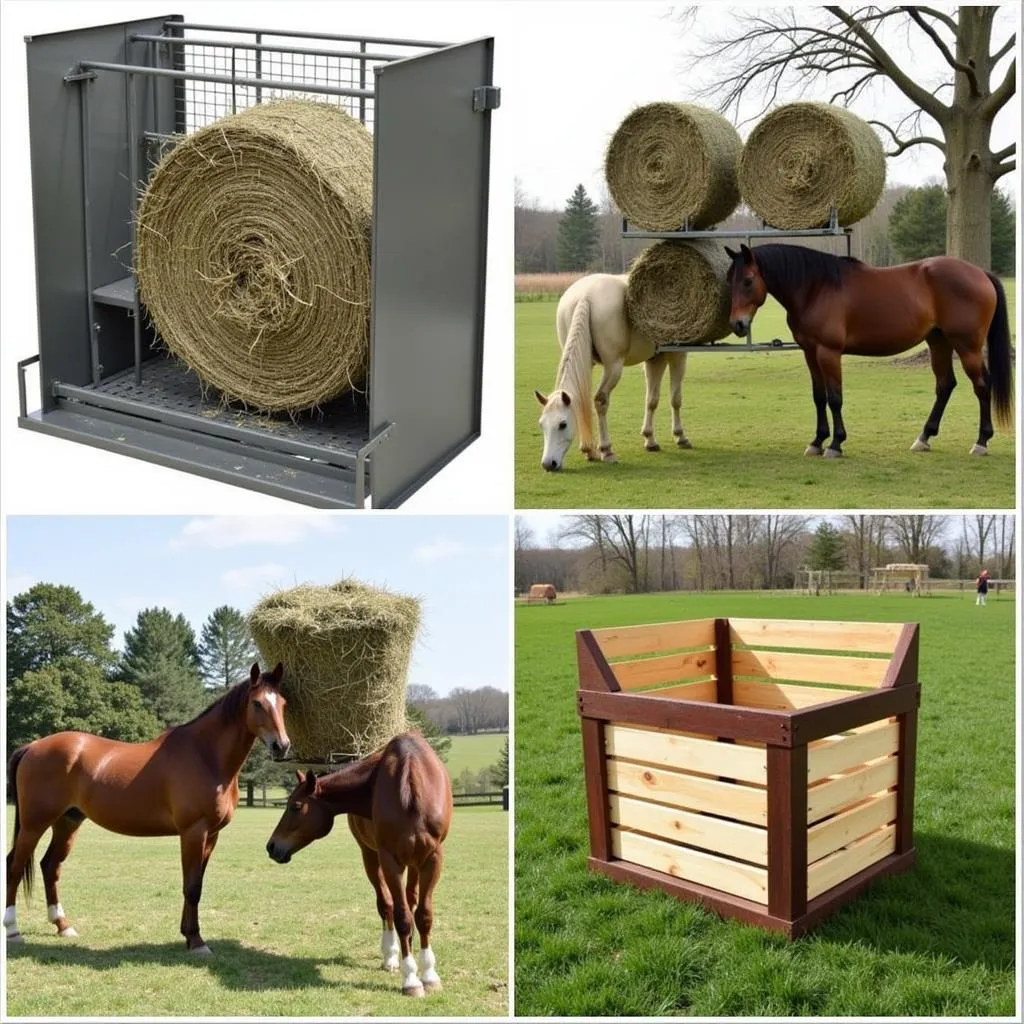Choosing the right hay feeder for your pasture is crucial for your horse’s health, minimizing waste, and ensuring efficient feeding. Whether you’re a seasoned horse owner or just starting out, “Justus Horses USA” is here to guide you through the best horse hay feeders for the field.
Why Use a Hay Feeder?
Simply tossing hay on the ground might seem economical, but it can lead to significant hay wastage and potential health risks for your horse. Here’s why investing in a quality hay feeder is a smart move:
- Reduced Waste: Hay feeders prevent horses from trampling and soiling their food, keeping it clean and palatable.
- Improved Digestion: Eating from the ground can increase the risk of ingesting sand and parasites, leading to digestive upset. Hay feeders promote a more natural grazing posture, aiding digestion.
- Controlled Intake: For easy keepers or horses requiring a specific diet, hay feeders help regulate consumption and prevent overeating.
Types of Field Hay Feeders
Choosing the right feeder depends on your herd size, budget, and specific needs. Here’s a breakdown of common types:
1. Round Bale Feeders
Ideal for larger herds, round bale feeders accommodate entire bales, reducing refill frequency. They come in various designs:
- Cone Feeders: Classic cone-shaped feeders with openings along the bottom ring.
- Ring Feeders: Circular feeders with metal or plastic bars, offering greater hay access.
- Cradle Feeders: Similar to ring feeders but with a cradle design for added stability.
2. Square Bale Feeders
Designed for smaller groups or individual horses, square bale feeders are available in different configurations:
- Wall-Mounted Feeders: Space-saving option attached to stable walls or fences.
- Trough Feeders: Simple rectangular troughs suitable for hay and grain.
- Combination Feeders: Combine hay and grain compartments for all-in-one feeding.
 Different Types of Horse Hay Feeders
Different Types of Horse Hay Feeders
Factors to Consider When Choosing a Feeder
Selecting the ideal feeder involves considering several factors:
- Herd Size: Choose a feeder that accommodates the number of horses in your pasture.
- Bale Size: Ensure the feeder is compatible with the size of hay bales you typically purchase.
- Material and Durability: Opt for sturdy materials like galvanized steel or heavy-duty plastic that can withstand weather and wear.
- Ease of Cleaning: Look for feeders with smooth surfaces and accessible compartments for easy cleaning and maintenance.
- Safety Features: Rounded edges, secure latches, and spacing between bars prevent injuries while feeding.
The Benefits of Slow Feeders
Slow feeders are becoming increasingly popular for their numerous benefits:
- Mimic Natural Grazing: Slow feeders prolong feeding time, encouraging horses to eat more naturally and reducing boredom.
- Improved Digestion: Slower consumption promotes better digestion and reduces the risk of colic and other digestive issues.
- Reduced Hay Waste: The design of slow feeders minimizes hay loss, saving you money in the long run.
 Horse Benefitting from a Slow Feeder
Horse Benefitting from a Slow Feeder
Maintaining Your Hay Feeder
Regular maintenance ensures your feeder’s longevity and your horses’ safety:
- Cleaning: Remove manure and uneaten hay regularly to prevent mold and bacteria growth.
- Inspection: Check for signs of wear and tear, such as rust, loose parts, or sharp edges. Repair or replace damaged parts promptly.
- Winter Care: Ensure proper drainage to prevent water from freezing and damaging the feeder.
Expert Insights
“Investing in a quality hay feeder is one of the best things you can do for your horses’ health and well-being,” says Dr. Emily Carter, Equine Veterinarian. “It’s a simple change that can make a big difference in their overall health and happiness.”
Conclusion
Choosing the right hay feeder for your field is an investment in your horse’s well-being. By understanding the different types, considering your specific needs, and prioritizing safety and functionality, you can create a feeding environment that promotes your horse’s health, reduces waste, and simplifies your chores.
Remember, a well-fed horse is a happy horse!
FAQs
- How often should I clean my horse’s hay feeder? It’s best to clean it at least once a week, or more frequently if needed, to prevent mold and bacteria growth.
- Can I use a round bale feeder for a single horse? While possible, it’s not ideal. Round bale feeders are better suited for larger groups. Consider a square bale feeder or slow feeder for individual horses.
- What material is best for a hay feeder? Galvanized steel and heavy-duty plastic are popular choices for their durability and weather resistance.
- Are slow feeders suitable for all horses? Yes, slow feeders can benefit horses of all ages, breeds, and activity levels.
- Where can I find high-quality horse hay feeders? Justus Horses USA offers a wide selection of durable and reliable hay feeders to meet your needs. Visit our website or contact us for expert advice.
Let Us Help You!
Have questions about choosing the perfect horse hay feeder for your field? Contact Justus Horses USA today! Call us at 0772127271, email us at [email protected], or visit our location at QGM2+WX2, Vị Trung, Vị Thuỷ, Hậu Giang, Việt Nam. Our dedicated team is available 24/7 to assist you.